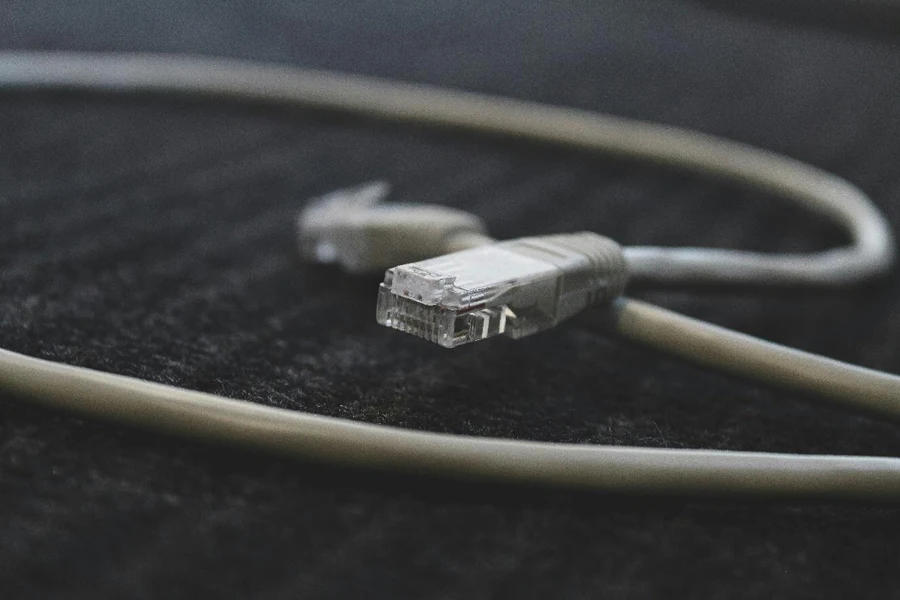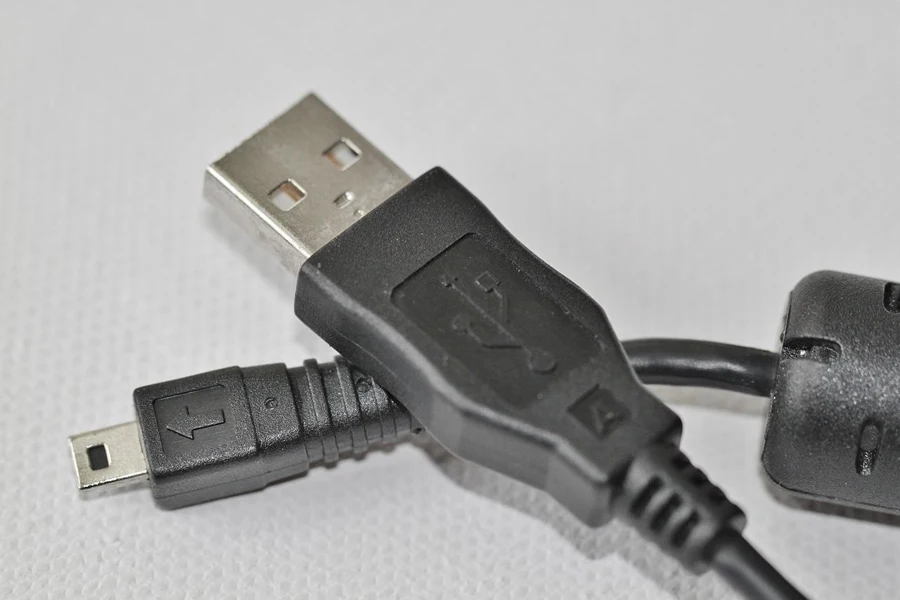USB cables have become essential for modern connections by enabling power and data transfer among devices. In the expanding market of USB cables driven by technology and demand surge, industry experts need to stay updated with the trends. This article explores the market shifts, new innovations, and popular models that influence the future of USB cables, offering guidance for professionals making purchasing decisions. To stay competitive in this changing industry, a strong understanding of these aspects and their impact on procurement tactics and product choices is crucial.
Table of Contents
● Market overview: The global surge in USB data cables
● Innovations powering USB data cables: From materials to technology
● Leading USB data cable models driving consumer choices
● Conclusion
Market overview: The global surge in USB data cables

Market growth and projections
The market for USB data cables is seeing expansion globally, with a value of USD19.2 billion in 2023 and an anticipated growth rate of 17.3% annually from 2023 to 2031, according to research by KBV research firm. The surge in popularity is mainly due to the growing use of USB Type-C cables that are now becoming the norm for devices like smartphones, laptops, and other consumer electronics. The Asia Pacific region is at the forefront of the market with the largest share predominantly because of its swift technological progress and the increasing need for quicker data transmission and effective power supply in various consumer and industrial sectors.
Market segmentation
The market is mainly divided into USB Type-C cables and power delivery cords. USB Type-C cables are the prevailing choice due to their flexibility and extensive use across various devices like mobile phones and laptops for their fast data transfer rate and effective power supply function. USB4 cables, which support data transfer speeds of up to 40 Gbps, are gaining traction, especially in high-performance computing and professional applications that require robust data transmission capabilities. Power delivery cables, which have evolved to handle higher power requirements, are becoming crucial in the market, particularly with the growing trend of charging devices via USB interfaces.
Impact of technological trends
Technological progressions are greatly impacting the USB data cables market. The rise of USB4 technology stands out as a major trend due to its capabilities to accommodate dual 4k displays and provide 100 watts of power delivery while maintaining compatibility with previous USB iterations. These features make USB4 a popular choice for applications that require advanced functionalities. Additionally, including enhancements like eMarker chips that improve charging safety and efficiency is fueling the need for more sophisticated USB cables. With the advancements in these technologies comes the anticipation of driving market expansion even more and influencing consumers to lean towards superior quality and high-performing cables.
Innovations powering USB data cables: From materials to technology

Material advancements
Cutting-edge advancements in USB data cable materials are centered around boosting performance and sustainability. High-conductivity copper alloys are gaining traction to reduce resistance in these cables. This directly leads to enhanced data transfer speeds and more efficient power usage. In response to growing environmental worries, manufacturers are shifting towards employing polymers for insulation. Not only does this choice help lessen the carbon footprint, but it also offers flexibility and durability. These materials are mixed with reused aluminum shielding to provide a strong defense against electromagnetic interference (EMI), all while keeping the cable lightweight and easy to bend. Moreover, modern thermoplastic elastomers (TPEs) are being added to USB cables to boost their ability to withstand damage from use and exposure to high temperatures, ensuring they last longer, even in tough environments.
Technological evolution

The advancements in USB standards have brought about enhancements in both speed and energy efficiency over time. The latest USB4 generation has raised the bar by supporting either two streams of 4K video or a single stream of 8K video, all thanks to its fast data transfer rate of 40 Gbps. This is an improvement from the previous speeds of USB 3.0 and 3.1, which could handle only up to 5 Gbps and 10 Gbps, respectively. Moreover, the introduction of USB Power Delivery (USB PD) version 3.1 has broadened the power capacity to 240 Watts, surpassing the limit of just one hundred Watts. This enables rapid charging of powerful devices like gaming laptops and monitors using a single USB cable. One great thing about adaptive voltage scaling in USB PD is that it ensures safe power delivery, reduces energy waste, and avoids overheating issues.
Design innovations
In the realm of USB data cables, design advancements are integrating features to elevate functionality and user convenience. For instance, with USB C cables, the integration of embedded marker chips facilitates communication between the cable and linked devices, enabling automatic power delivery adjustments tailored to the specific needs of the device. This innovation enhances charging speed and shields devices from potential harm from sudden power spikes. The advancement of smoke and zero halogen (LSZH) insulation materials is a crucial innovation that greatly enhances fire safety by minimizing the release of harmful fumes during fires. In addition to this improvement in safety measures is the integration of layer shielding methods such as braided copper mesh and metal foil wraps to boost the cable’s capacity to fend off external electromagnetic and radio frequency disturbances effectively. This ensures uninterrupted data transfer performance even in settings with elevated electronic interference levels. These progressions play a big role in upholding top-notch efficiency for tasks that require precision and speed, like transmitting high-quality videos or swiftly transferring data in professional environments.
Leading USB data cable models driving consumer choices

Belkin BoostCharge 240W: Power and safety combined
The Belkin BoostCharge 240-watt USB C cable is a top choice among buyers for its ability to handle powerful charging needs effectively and efficiently on the market today. The cable’s capability to support up to 240 watts of power makes it perfect for powering up high-performance laptops, gaming gadgets, and large screens. The presence of eMarker chips guarantees the efficient distribution of energy. It also adds an extra layer of protection against overheating to ensure the safety of both the cable and connected devices. Its sturdy woven pattern contributes to its attractiveness, ensuring consistent performance even with frequent usage.
Cable Matters USB4: Designed for speed and versatility
The 6-foot USB Type C cable from Cable Matters is a great option for individuals looking for a versatile solution that effectively covers charging and data transfer needs. Featuring 40 Gbps data transfer rates enables this cable to excel in tasks demanding swift data processing, such as effortlessly editing high-resolution 4K videos or transferring large files. Moreover, with its capability to support 100-watt power delivery, it becomes a choice for charging high-powered devices like laptops while seamlessly managing data-heavy operations. Professionals often rely on this cable for its speed and power output, ensuring reliable high performance.
Anker Powerline+ III: Durability meets everyday functionality
The Anker Powerline+ III USB-C cable is a top choice among customers who value durability and practicality in their tech accessories. The cable features a quality nylon braided exterior that has been rigorously tested to endure more than 35,000 bends, making it one of the sturdiest options. It can support 60 watts of charging power for smartphones, tabs, and smaller laptops. Thanks to its sturdy construction and reliable performance, this cable has become a go-to option for individuals looking for a lasting charging solution.
SOOPII 100W USB-C: Innovation with real-time feedback
The SOOPII 100-watt USB-C to USB-C cable stands out from its competitors with a unique touch—a digital screen that shows live charging speeds in real-time. With the ability to pump out a maximum of 100 watts of power output, this cable is perfect for juicing up devices ranging from smartphones to bigger laptops. The display adds a dash of transparency by letting users keep an eye on how their gadgets are charging, making it a hit among tech fans and those who like to have a tight grip on their device’s power usage.
AmazonBasics USB-C 3.1: Affordability with essential performance
Budget-friendly shoppers often gravitate towards the AmazonBasics USB-C 3.1 cable as it delivers top performance without breaking the bank. Despite its price, this cord boasts impressive specs, such as 10 Gbps data transfer speeds and 60W charging capability, making it a convenient pick for daily usage. Its straightforward and efficient design guarantees functionality, earning it favor with customers seeking a trustworthy USB-C cable minus the extra expense of high-end features.
Conclusion

The market for USB data cables is rapidly changing due to technological advancements in materials, data transfer speeds, and power delivery. They improve performance and meet the increasing need for durability and eco-friendliness. As the industry progresses towards intelligent designs and seamless integration of technology features into USB cables, these products are becoming essential for future connectivity needs across different sectors. The continuous progress in this area will greatly influence the design of electronic gadgets and infrastructure worldwide, becoming a crucial element in the ever-evolving technology field.



